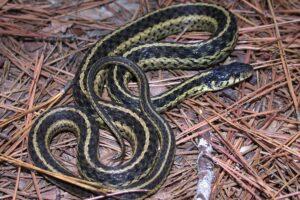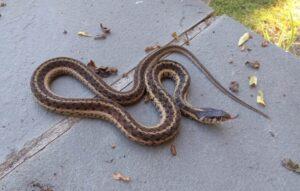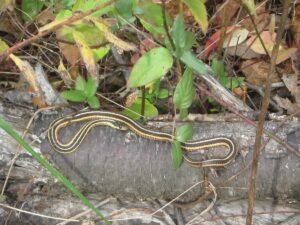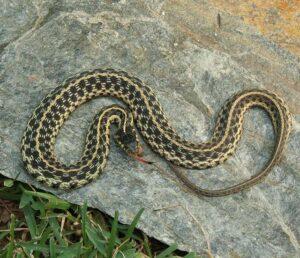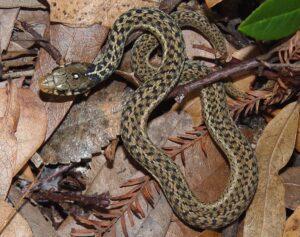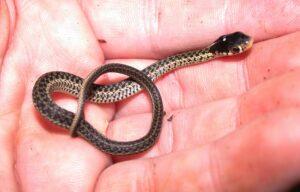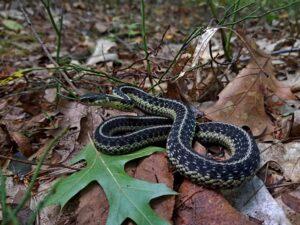Eastern Garter Snake (Thamnophis sirtalis sirtalis)
Updated on
25/04/2024The medium-sized eastern garter snake is a native of North America. Its scientific name significantly refers to its habitat and color pattern. ‘Thamnos’ in Greek means bush, ophis stands for a snake, and sirtalis refers to the garter stripes on the snake’s body resulting in its name. Like all other members of its family, the eastern garter is a harmless snake, striking and biting out of aggression. It has been Virginia’s state snake since 2016.
Scientific Classifications
- Suborder:Serpentes
- Family:Colubridae
- Genus:Thamnophis
- Species:T. sirtalis
Conservation Status
Description
Size
These medium-sized snakes measure between 18 and 26 inches and can reach a maximum length of around 49 inches. The female garters are bigger than their male counterparts.
Color and Appearance
The eastern garter snake has a distinctive color pattern – dark brown, olive, or a green back marked with white or yellow stripes running through the center. There may even be two less prominent stripes running parallel to the sides, varying in color from white to yellow, brown to green, or even bluish. In rare cases, some garter snakes may have an all-black body sans the stripes. The area within the stripes has green or black spots arranged in a checkboard pattern.
Their belly appears yellowish-green with indistinct black spots arranged in two rows, mostly overlapped by their keeled scales.
The juvenile garter snakes closely resemble adults in color and appearance.
Are They Dangerous to Humans
These nonvenomous garter snakes are harmless, not posing a danger to humans. They could only attack and bite humans when provoked or if they feel threatened. Before lashing out, they mostly release a foul-smelling liquid as a warning sign of their attack. The consequence of their bite results in itching or minor swelling.
Eastern Garter Snake at a Glance
Distribution
The eastern garter snake is found throughout eastern North America, extending to parts of Canada, including Quebec and southern Ontario. It is even found along the Gulf of Mexico, throughout New England, east Texas, and Minnesota.
Habitat
They have diverse habitats, particularly liking shrubby fields, grasslands, trash dumps, and abandoned farmlands. They live in gardens, cemeteries, suburban yards, and city parks in urban environments.
One could even spot them near moist habitats like streams, rivers, lakes, ponds, bogs, quarries, ditches, and drains. During winter, these snakes take refuge under big rocks, logs, caves, stones, and animal burrows when they go into hibernation.
Lifespan
They have an average lifespan of 3-4 years in the wild and over 10 years in captivity.
Predators
These medium-sized snakes have several predators, including raccoons, bullfrogs, skunks, hawks, and larger snakes.
Diet
They feed on tadpoles, frogs, toads, earthworms, salamanders, minnows, mice, worms, and other small snakes.
Reproduction
They mate during spring, after emerging from hibernation. Several males try mating with a single female resulting in a breeding or mating ball. The females don’t lay eggs but are ovoviviparous, giving birth to live young, 10-40 snakelets in a single litter after a gestation period of 2-3 months. The young measure 5-9 inches when born and are independent right from the start. The male garter snakes attain sexual maturity at 1.5 years and the females at 2 years.
Care Sheet
Housing
You could keep them in a large container, preferably made of plastic. These snakes would require a total space of around 15 gallons.
Temperature
A room temperature of 70 °F is ideal for them.
Substrate
Substrates of peat moss, coco fiber, newspaper, and soil would work. Adding logs and rocks would help them hide, while small branches and fake foliage may serve as ideal climbing spots.
Feeding
A diet of live small live fish, worms, slugs, and small frogs would suffice.
FAQs
Both appear similar but differ from the other in their stripes’ color. The stripes are light in the common garter and dark in the eastern garter.
The ribbon snakes are more slender-bodied with fewer markings than the eastern garter.
Source
herpsofnc.org, clemsonhgic.wpenginepowered.com, nps.gov, picryl.com, herpsofnc.org, jaxshells.org, ukrbin.com

